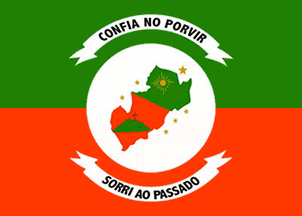 image by Dirk Schönberger,
16 March
2010
image by Dirk Schönberger,
16 March
2010
Last modified: 2012-02-11 by ian macdonald
Keywords: ceará | várzea alegre |
Links: FOTW homepage |
search |
disclaimer and copyright |
write us |
mirrors
 image by Dirk Schönberger,
16 March
2010
image by Dirk Schönberger,
16 March
2010
Based on http://pt.wikipedia.org/wiki/V%C3%A1rzea_Alegre
Horizontally divided green over red, in center a white disk bearing a map of the municipality, divided diagonally green over red; in the red part a golden sun, in the green part a silhouette of a red hill with a cross; five small golden stars and one larger golden star around the map.
Official website at
http://www.varzeaalegre.ce.gov.br. The flag is shown on the prefectural
website at
http://www.varzeaalegre.ce.gov.br/bandeira.htm.
Dirk Schönberger, 16 March 2010
The municipality of Várzea Alegre (37,740 inhabitants in 2007; 836 sq. km)
is located 470 km of Fortaleza. The municipality is made of the town of
Várzea Alegre proper (21,997 inh.) and of the rural districts of Calabaçao
(95 sq. km, 17 settlements; founded in 1938 by State Decree No. 448),
Canindezinho (120 sq. km, 25 settlements; founded in 1951 by State Decree No.
1,153), Ibicatú (125 sq. km, 19 settlements; founded in 1938 by State Decree
No. 448), Naraniú (135 sq. km, 31 settlements; founded in 1933 by State
Decree No. 1,156), and Riacho Verde (115 sq. km, 29 settlements; founded in
1933 by State Decree No. 1,156).
Várzea Alegre is one of the few
municipalities in Ceará whose name was never changed. The early colonists
already called Várzea Alegre (lit. "the happy valley") the valley where the
paths from Cariri and Crato joined. The municipality was founded by
Provincial Law No. 1,329 of 10 October 1870, seceding from the municipality
of Lavras da Mangabeira. Inaugurated on 2 March 1872, the municipality was
suppressed by Decree No. 193 of 20 May 1931, being incorporated to the
municipality of Cedro. Várzea Alegre, however, was quickly reestablished as a
municipality by Decree No. 1,156 of 4 December 1933.
The flag of Várzea
Alegre is prescribed by Municipal Law No. 6 of 22 September 1968.
"Article 1.
The flag is made of two equal horizontal stripes, green and red,
with, in the middle, a big white disk charged with a map of the
municipality, also [diagonally] half divided green-red. The green part of the
map is charged with a star as a symbol of a bright future; the red part of
the map is charged with a hill topped with a cross to characterize the
emerging civilization and the local religious traditions. The map is
surrounded by six golden stars placed on the white disk, symbolizing the six
districts forming the municipality. The central disk is surrounded by two
scrolls, one at the top, inscribed with "CONFI NO PORVIR" [Trust in the
Future], one at the bottom inscribed with 'SORRI AO PASSADO" (Smiling to the
Past].
Article 2.
The proportions of the flag are 14 M in height on 20
M in width, "M" being an arbitrary unit. The diameter of the central disk is
6.5 M. [...] The central map has its outer points located at 0.6 M from the
disk border. The scrolls are placed 1 M from the disk border."
The flag
was imagined by Tibúrcio Bezerra, based on the saga of the municipality and
its inhabitants, as a symbolical summary of its formation. The red stripe
represents the blood and strength of the builders of the municipality. The
green stripe represents the exuberant vegetation and hope expressed
generation after generation. The white disk represents the earth. The
division of the map symbolizes the imaginary lines that divide history. In
the northern part appears the sun, always lightning the way to the future. In
the southern part, the cross on the hill symbolizes the Christian origin
of the municipality, described in our ancestors' history. Around the map, the
bigger star represents the seat of the municipality, while the five smaller
stars represent the districts of Naraniú, Canindezinho, Calabaço, Riacho
Verde and Ibicatú. The stars are yellow, representing the piles of harvested
rice grains so common on the valleys of the municipality.
http://www.varzeaalegre.ce.gov.br/bandeira.htm - Municipal website
http://www.varzeaalegre.ce.gov.br/fotonova_48.htm - Photo of the flag
(outdoors)
http://www.varzeaalegre.ce.gov.br/mat326_01.jpg - Photo of the
flag (indoors)
Ivan Sache, 16 January 2012